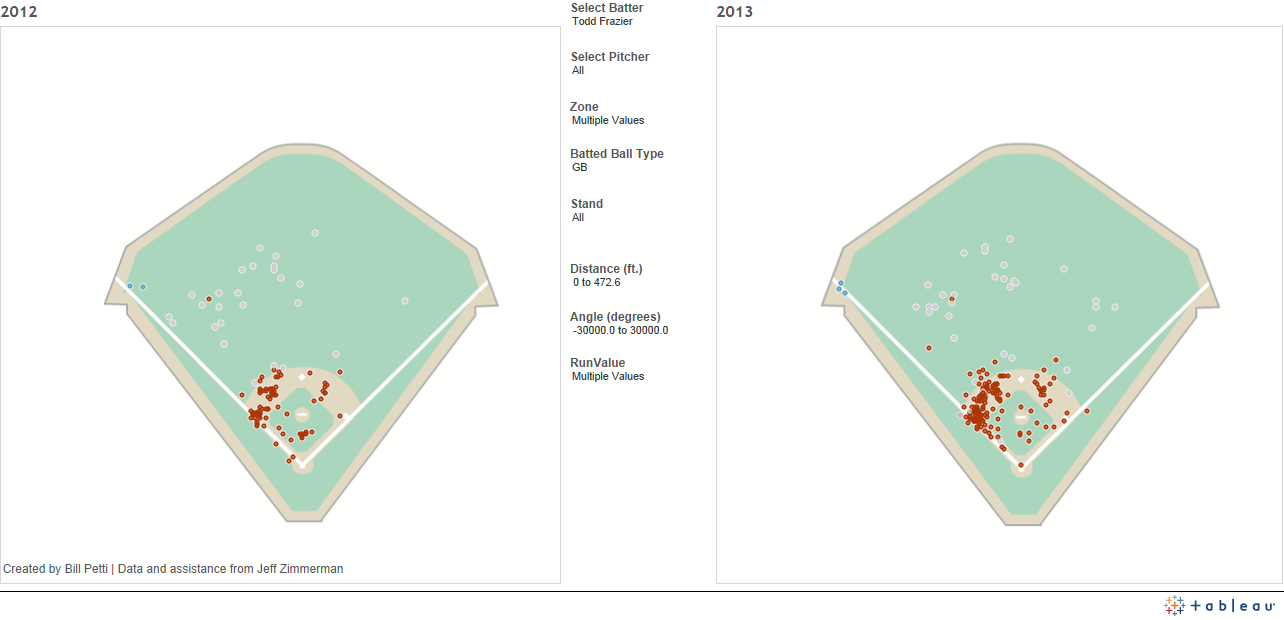Can Todd Frazier Rebound From Sophomore Slump?
Although the RotoGraphs team recapped the third base position a few weeks ago, Todd Frazier didn’t receive his due attention, so it seemed prudent to give him ample space in our discussion on outfielders — the only other position he played last season. The New Jersey native was a popular sleeper pick after posting a solid .354 wOBA (8th amongst third basemen with 400+ PA) with 19 home runs and finishing third in the NL Rookie of the Year voting in 2012.
Unfortunately, Frazier delivered a disappointing sophomore campaign this year. His batting average plummeted to a mere .234, his wOBA dropped to .319, and his home run numbers remained stagnant despite roughly 150 more plate appearances. Barely checking in ahead of D.J. LeMahieu, Juan Uribe and Matt Dominguez, the 27-year-old ranked as the 17th-best fantasy third baseman. That’s a far cry from where many fantasy owners expected him to be ranked at the end of the season.
Some fantasy analysts have pointed to the severe drop in BABIP from .316 to .269 in 2012 and 2013, respectively, as the main reason for Frazier’s decreased value. They’ve pointed to the increased walk rate, the decreased strikeout rate, the decreased swinging-strike rate and even to the fact that he swung at fewer pitches outside the strike zone in 2013. All good things, certainly, but I’m not ready to jump aboard the BABIP train and simply explain away his struggles this year to mere random variation. That’s too simplistic and misses a key reason why his power and batting average dropped this season.
Frazier regularly displayed above-average power in the minors, and his power showed in 2012. He got the baseball in the air often and gave himself ample chances to capitalize on his power. However, his ground ball rate increased from 32.9% a year ago to 42.2% in the 2013 season. That’s a significant jump for a player without good speed, as it limits his power opportunities and places more of his offensive value in his BABIP and batting average, where fantasy owners specifically experienced the pain.
And when a player without plus speed is pounding more ground balls — to be fair, it’s not that Frazier has a massive ground ball rate by any stretch — the BABIP usually doesn’t respond well. Looking at his ground ball profile from the past two seasons, we can clearly see Frazier hit many more ground balls and it was most often to his pull side.
We shouldn’t be surprised that both his ISO and BABIP dropped with such a ground ball spray chart in 2013. It should be noted, though, that his HR/FB remained close to his 2012 numbers and his ISO didn’t drop dramatically, which suggests his overall power production could’ve taken the jump many people predicted if he hadn’t put the baseball on the ground so often.
It doesn’t appear to have been a platoon issue, either. He hit for more power against lefties, but his ground ball percentage remained relatively level against both lefties and righties and his batting average was almost identical. Many immediately gravitate toward platoon splits — and rightfully so in many cases — but Frazier doesn’t fit that mold.
Perhaps the answer lies in this article by Baseball Analytics, which suggests Frazier is hitting many more ground balls on inside pitches this year. Such an explanation would certainly fit the above spray chart.
I’m not in a position to postulate whether Frazier will continue to hit the baseball on the ground next season. I did not watch enough of his at-bats to single out any mechanical flaws. We also only have two seasons with which to work, and Minor League Central doesn’t have his minor splits prior to 2011, which leaves us with an unsatisfactory sample. Frazier seems to be a good bet for 15-20 home runs regardless of his batted ball profile. That’s valuable. That value simply takes a massive hit with a batting average south of .250, which is why his ground ball rate seems to be so important. If he gets the baseball off the ground more often in 2014, perhaps his home run numbers can jump above 20 and his batting average can return to a much more palatable .270-.280.
Late in fantasy drafts, Frazier has value. I like his power potential much more than what we can expect from guys like David Freese or Matt Dominguez, who should come off the board at roughly the same time. And if you’re someone who believes he can adjust to his struggles on the inner half and stop weakly grounding out so often, he would represent solid value later in drafts. If you’re someone who believes pitchers have simply adjusted to Frazier and he’ll continue to hit more ground balls, he’s not necessarily an attractive candidate for improvement. In that case, the 2013 numbers may be as good as it gets.
J.P. Breen is a graduate student at the University of Chicago. For analysis on the Brewers and fantasy baseball, you can follow him on Twitter (@JP_Breen).

3B isn’t the easiest of positions to work with. I’d take a mid-teens pick on him, preferably at CI, just for the homeruns alone.